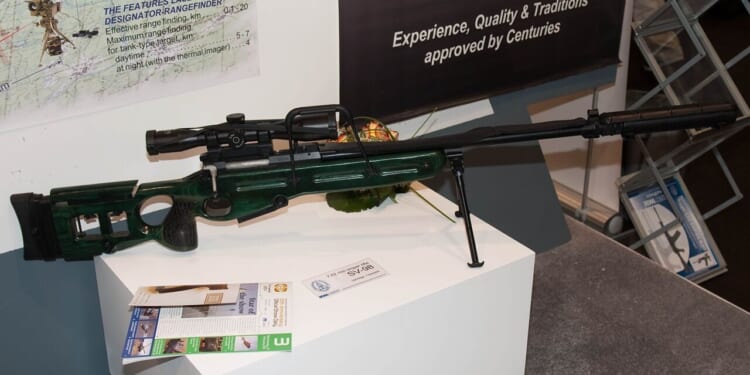Russian special operations troops first used the SV-98 sniper rifle in the conflict in Chechnya, and it continues to be used in the ongoing war in Ukraine.
The Kalashnikov Concern, Russia’s legendary small arms manufacturer, announced this week that it had delivered a new batch of SV-98 (Snaiperskaya Vintovka Model 1998) bolt-action sniper rifles to its forces now fighting in Ukraine. The exact number of new rifles wasn’t announced, but small arms production has been one area where Russia has been able to meet, and even exceed, demand.
“The Kalashnikov Group has delivered a large batch of 7.62mm SV-98 high-precision sniper rifles to the customer under the existing 2025 state contract. The rifles that are widely used in the zone of the special military operation were delivered precisely on schedule,” Kalashnikov’s press office said in a statement to Russian news agency TASS.
The Kalashnikov Concern currently supplies about 95 percent of all small arms used by the Russian military, paramilitary, and police forces. It also exports to more than two dozen countries around the world.
The company’s origins can be traced back to Tsar Alexander I of Russia, who founded it in 1807 as an Imperial Russian military arsenal. It remained under state control following the Russian Civil War, and for most of its life was known as the Izhevsk Machine-Building Plant. However, in 2013, the company was renamed for legendary Soviet gun designer Mikhail Kalashnikov, famed for leading the development of the eponymous AK-47 assault rifle.
What to Know About Russia’s SV-98 Sniper Rifle
Development of the SV-98 began in the mid-1990s under the direction of Vladimir Stronskiy at Izhmash, now part of the Kalashnikov Concern. It first entered service in 1998, issued primarily to Russian “special operations forces” and law-enforcement snipers. It is able to “engage enemy personnel by aimed fire at a distance of up to 1,000 meters,” or roughly 1,100 yards, with a muzzle velocity of 820 m/s.
The bolt-action rifle is built around a cold-hammer-forged receiver and a cold-hammer-forged free-floating chrome-lined heavy barrel, which can be used with a sound/flash suppressor. It is chambered for the widely employed 7.62x54mmR rimmed rifle cartridge, but the gunmaker noted it is most accurate when used with the 7N1 and 7N14 cartridges, which were developed for the Dragunov SVD and utilize a match-grade extruded powder rather than the coarser ball propellant used with the more common rounds. It is fed from a 10-round box magazine.
The SV-98 has an overall length of 1,375 mm (54.1 in) with suppressor, a barrel length of 650 mm (25.6 in), and a weight of 7.8 kg (17.2 lb) empty. It has a trigger pull that can be adjusted between 1.0 kgf and 1.5 kgf. Designed to be ergonomically efficient, the bolt-action rifle is outfitted with an aluminum alloy stock, a polymer pistol grip, a buttstock with an adjustable cheek riser, and a monopod post. A variety of optics can be fitted on its Picatinny MIL-STD-1913 rail, but it is also equipped with iron sights.
Russian special operations troops first used the SV-98 sniper rifle in the conflict in Chechnya, and it continues to be used in the ongoing war in Ukraine.
In addition to the Russian military and paramilitary forces, the SV-98 had been adopted by Syrian Republican Guard forces under the regime of Bashar al-Assad, and was also exported to Armenia.
A sporting version based on the SV-98 was released as the SV-338, SV-338M, and SV-338 M1, but chambered for the .338 Lapua Magnum (8.6×70mm or 8.58×70mm) cartridges.
About the Author: Peter Suciu
Peter Suciu has contributed over 3,200 published pieces to more than four dozen magazines and websites over a 30-year career in journalism. He regularly writes about military hardware, firearms history, cybersecurity, politics, and international affairs. Peter is also a contributing writer for Forbes and Clearance Jobs. He is based in Michigan. You can follow him on Twitter: @PeterSuciu. You can email the author: [email protected].
Image: Shutterstock / Flying Camera.


















